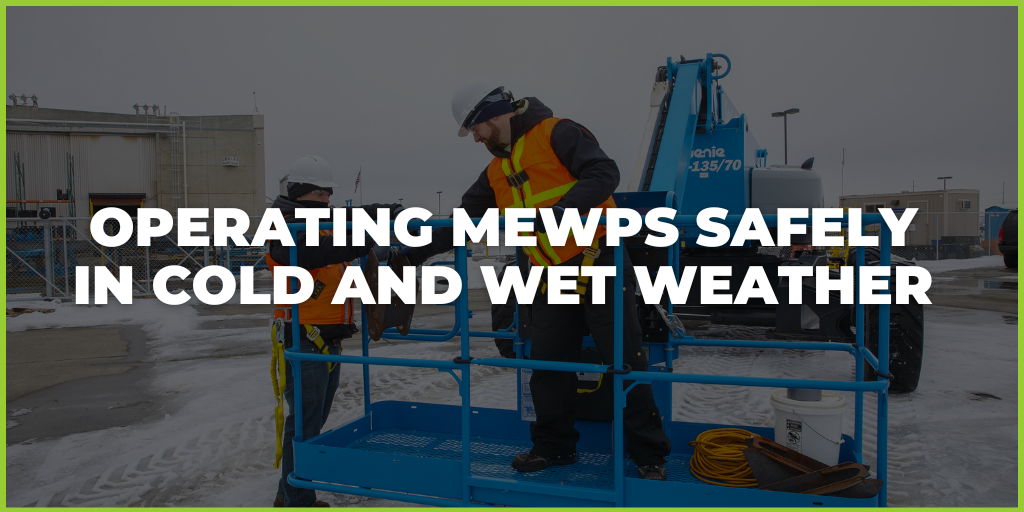Do you have a MEWP rescue plan?
If you are working at height using a Mobile Elevating Work Platform (MEWP), cherry picker, scissor lift or powered access platform it is essential that you have a well-considered and thorough rescue plan in place. To be used in the event of an accident/incident or an equipment malfunction.
What is a MEWP rescue plan?
A rescue plan is a procedure designed to safely retrieve operators from a MEWP in case of malfunction or emergency. A rescue plan must be in place and communicated before any person operates a MEWP at height.
Why do you need rescue procedures?
In the UK over three million people are working at height as part of their job, and there are plenty of risks associated with it. Falls from height remains the biggest cause of death and serious injury at work. In the UK 35 people were sadly killed by falling from height in 2021 according to the HSE work-related fatal injuries in Great Britain Report 2020/21. These statistics emphasise just how essential it is for you to take adequate measures, and have a rescue plan in place.
A rescue plan is essential to ensure that operators are safe and can be accessed quickly in the event of an emergency. A robust, documented rescue procedure is required to lower the MEWP platform occupants in case of a malfunction or emergency.
An emergency situation may be caused by:
- MEWP stopped due to no fuel or low battery
- MEWP malfunction
- Trapped platform or MEWP upper structure
- Platform overload
- Operator/occupant distress (health issues, entrapment, electrocution, etc.). Other emergencies.
Quickly rescuing someone who has become trapped can make a very significant difference to the injuries sustained. Any delay in rescuing the MEWP platform occupants may be the difference between life and death.
Risk Assessments
You need to conduct a risk assessment before starting any work at height and must postpone work if rescue procedures are insufficient.
There are five steps to a risk assessment:
- Identify the hazards
- Decide who might be harmed and how
- Evaluate the risks and decide on precautions
- Record your findings and implement them
- Review the risk assessment and update where necessary.
If you would like to read more about how to develop a working at height risk assessment, click here to download the HLS Risk assessment template
When is a rescue plan needed?
Health and safety legislation requires a safe system of work for all work activities and is a legal requirement. A rescue plan must be communicated before any person operates a MEWP at height. Read and rehearse the rescue plan BEFORE you need it.
What are the factors to consider while designing the MEWP rescue plan?
Every worksite that contains people who work at height needs to have its own rescue plan. This is because every site is different, and so one plan is unlikely to cover every area. You must also consider any fall protection equipment that may or may not be worn by the casualty at the time. Additionally, preparations must be made for potential casualties that are suspended and also out of reach.
Before you write the rescue plan, you need to consider some procedural points:
- The type of rescue system, i.e. will a self-rescue be possible or will assistance be required?
- Preparation should be undertaken before work commences. For example, a rescue kit should be at the site in advance.
- There must be sufficient workers on site who are trained in rescue procedures and equipment handling. They should also be able to assess the situation, make contact with the fallen worker, alert the company of the accident, and call the emergency services.
- The rescue plan should align with the overarching company health and safety policy and guidelines.
- The type of rescue required is most likely based on the place of work and the likely fall. There are broadly speaking 4 types of rescue: Lowering a casualty, raising a casualty, self-evacuation by descent or rescue someone else who is in descent.
There are a few key things you should take into consideration when creating your rescue plan.
- The type of equipment required
- The suitability of the equipment being used
- Training requirements for MEWP operators and nominated rescuers
- The maintenance of the rescue system and its efficiency
- The method that will be used to recover the casualty
- MEWP technical advice may be needed during the planning process. To obtain this contact the machinery supplier.
- The anchor points used for the rescue (which must be adequate)
- Who will be in the vicinity if a rescue is needed?
- Are ground rescue personnel familiarised and competent in the rescue process?
- Do they know how to use the ground controls, the auxiliary and emergency descent systems?
- How will you communicate with the MEWP operator when the platform is elevated?
- Can the MEWP operator operate the platform controls?
- The safety of the person carrying out the rescue or assisting with it as well as the stress and demands on the rescuer
- The training needed by the rescuer before they are able to perform rescue
- The direction that the casualty will need to be moved
- The medical requirements (minor and severe) that the casualty will have
- The potential needs of the casualty following the rescue
The plan itself should include the following information:
- Details of the equipment to be used in the event of a rescue including where it will be stored
- How the equipment will be configured for the different types of rescue.
- How often the equipment is serviced and inspected and where records of the prior inspections shall be stored.
- What the rescue kit will contain and where it will be located
- Anchor point identification if appropriate
- Limitations of the plan, for example for poor weather conditions
- The trained individuals who will be available to action the rescue plan
- The type of emergency medical assistance is likely to be required immediately after a fall
What is required?
- Your employer must provide you with a documented rescue plan BEFORE you elevate.
- The rescue plan must identify how the MEWP will be returned to ground level or a safe area, in case of an incident at height.
- The Rescue Plan should also identify who is (are) the Nominated Ground Rescue Person(s).
Note: Some MEWPs may require more than one physically fit person to operate the auxiliary/emergency descent system.
The operator should test the functionality of the ground and the auxiliary/emergency lowering systems during the pre-use inspection. For more guidance on how to complete a pursue inspection, download our MEWP pursue inspection checklist.
The Nominated Ground Rescue Person(s) should:
- Be available and at ground level when the MEWP is in use;
- Be familiarised with the MEWP’s ground and auxiliary/emergency controls; practice the rescue procedures through rescue drills;
- Have a method of communication with the MEWP operator and platform occupants
What should the MEWP user do?
- Identify, train and familiarise your nominated ground rescue person(s).
- MEWP manufacturers have different procedures to lower the platform from the ground and auxiliary/emergency controls. Ensure MEWP Operator Manual is with/on machine and familiarise yourself and the rescuer with the emergency lower procedure
- Only allow the MEWP to be operated after a documented rescue plan is in place and practiced
- Brief operators to position the MEWP such that the ground control and any rescue control panel are fully accessible to the Nominated Ground Rescue Person(s)
What should be considered when nominating ground rescue person(s)?
- They understand the site constraints and hazards when operating the ground and auxiliary/emergency lowering systems.
- They know the manufacturer’s instructions to safely control the MEWP platform to a safe rescue position. Perform regular rescue drills to avoid panic.
Who’s responsible for the rescue plan and operations?
It’s usually the MEWP operator’s responsibility to ensure appropriate planning has taken place, with adequate provisions available in the event of a rescue operation. So if you hire the equipment, don’t expect the MEWP hire company to do this for you. If you are using a contractor to operate the MEWP you will need to liaise with them to ensure that all aspects of the rescue plan can be implemented at your site.
What should be done after a rescue has taken place?
The rescue plan should outline what happens after a rescue has taken place:
- Isolate the machine (remove the keys)
- Tag the machine
- Report the incident to the user.
- Investigate the cause of why a rescue was required
What to do next
Brief all personnel on the rescue plan and practice the emergency procedures.
The user must:
- Lead the rescue or nominate in the rescue plan, a ground rescue person that is familiarised and competent with the MEWP
- Keep the plan readily available and visible
- Conduct periodic reviews of the rescue plan to check for changes in the worksite, operations, etc
- PRACTISE the plan regularly
- The nominated ground rescue person must be: Familiarised with the ground and auxiliary descent systems of all the MEWPs covered in the rescue plan and be available to conduct rescue whenever MEWPs are in operation.
Rescue plans are of no use if they are produced and are then locked away in a drawer. The rescue plan should be a living document that is updated:
- At least once per annum.
- After a fall/emergency.
- If there is a change in equipment, change of site, or change of anything of substance within the plan.
In summary, the importance of a rescue plan should be evident – particularly in the event that a fall arrest system is being used and it is the organisation’s responsibility (not the emergency services) to rescue the worker/s. Therefore it is advisable to engage with a work at height specialist who can provide assistance to create an appropriate rescue plan.
For further guidance on rescue planning, click on the link to download our free work at height rescue plan template.
www.hls.co/work-at-height-rescue-plan-template
HLS offers a site survey service (more information here) in which we assess your work environment, identify equipment needs, discuss your training and maintenance requirements, and use this information to make recommendations and devise an action plan.





